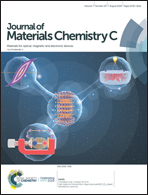A thieno[3,4-b]pyrazine-based A2–A1–D–A1–A2 type low bandgap non-fullerene acceptor with 1,1-dicyanomethylene-3-indanone (IC) as the terminal group†
Abstract
As the most successful end-capped unit in conventional A–D–A type non-fullerene acceptors (NFAs), 1,1-dicyanomethylene-3-indanone (IC) plays a significant role in enhancing the power conversion efficiencies (PCEs) of organic solar cells (OSCs). Here, an A2–A1–D–A1–A2 type NFA of TP28, containing the bridge unit of thieno[3,4-b]pyrazine (TP) and the terminal unit of IC, is designed and synthesized. This is the first time that IC groups are introduced into the A2–A1–D–A1–A2 type NFAs. By selecting four kinds of common electron-withdrawing units including benzothiadiazole (BT), quinoxaline (Qx), benzo[d][1,2,3]triazole (BTA) and TP, we found that the steric hindrance of the A1 unit may be the key factor in controlling the condensation reaction and only the TP unit could obtain the target molecule. Although the electron-donating capability of the central fluorene unit is relatively weak, TP28 exhibits a quite narrow optical bandgap of 1.47 eV. The PBDB-T:TP28 photovoltaic devices demonstrate a moderate PCE of 5.31%, revealing great potential of such kind of NFA for highly efficient bulk-heterojunction (BHJ) OSCs.
![Graphical abstract: A thieno[3,4-b]pyrazine-based A2–A1–D–A1–A2 type low bandgap non-fullerene acceptor with 1,1-dicyanomethylene-3-indanone (IC) as the terminal group](/en/Image/Get?imageInfo.ImageType=GA&imageInfo.ImageIdentifier.ManuscriptID=C9TC01758E&imageInfo.ImageIdentifier.Year=2019)


 Please wait while we load your content...
Please wait while we load your content...